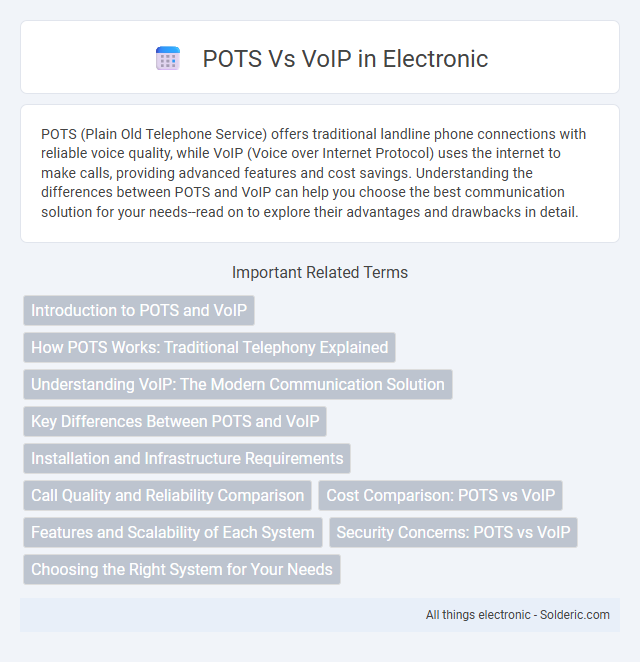POTS (Plain Old Telephone Service) offers traditional landline phone connections with reliable voice quality, while VoIP (Voice over Internet Protocol) uses the internet to make calls, providing advanced features and cost savings. Understanding the differences between POTS and VoIP can help you choose the best communication solution for your needs--read on to explore their advantages and drawbacks in detail.
Comparison Table
| Feature | POTS (Plain Old Telephone Service) | VoIP (Voice over Internet Protocol) |
|---|---|---|
| Technology | Analog circuit-switched network | Digital packet-switched network over the internet |
| Cost | Higher monthly fees and call rates | Lower cost, often free or low monthly fees |
| Call Quality | Consistent, reliable voice quality | Variable; depends on internet connection speed and stability |
| Setup | Requires physical phone lines | Requires broadband internet and compatible devices |
| Features | Basic calling features | Advanced features: video calls, voicemail, conferencing, integration |
| Portability | Tied to physical location | Accessible anywhere with internet |
| Power Dependency | Works during power outages | Depends on power and internet availability |
| Emergency Services | Reliable 911 location tracking | May have limitations in accurate location for emergency calls |
Introduction to POTS and VoIP
POTS (Plain Old Telephone Service) refers to the traditional analog telephone system that transmits voice over copper wires, ensuring reliable and high-quality calls. VoIP (Voice over Internet Protocol) converts voice signals into digital data, enabling phone calls over the internet with greater flexibility and cost efficiency. Understanding the differences helps you choose between the time-tested stability of POTS and the modern features of VoIP for your communication needs.
How POTS Works: Traditional Telephony Explained
POTS (Plain Old Telephone Service) operates through an analog signal transmitted over copper wire infrastructure established for decades. Your voice converts into electrical signals and travels via a circuit-switched network that ensures a dedicated connection during calls. This traditional telephony system contrasts with VoIP, which uses internet protocol to deliver voice communication.
Understanding VoIP: The Modern Communication Solution
VoIP (Voice over Internet Protocol) transforms traditional communication by transmitting voice data over the internet rather than conventional phone lines used by POTS (Plain Old Telephone Service). This modern technology offers enhanced scalability, cost efficiency, and a range of advanced features such as video calls, voicemail-to-email, and integration with other digital platforms. Understanding VoIP empowers your business or home setup with flexible, high-quality communication tailored for today's connected world.
Key Differences Between POTS and VoIP
POTS (Plain Old Telephone Service) relies on traditional analog technology and fixed copper lines, providing consistent voice quality and power during outages. VoIP (Voice over Internet Protocol) uses internet connectivity to transmit voice data digitally, offering advanced features, cost savings, and flexibility through software integration. Understanding these key differences helps you choose the best communication solution based on reliability, cost, and functionality needs.
Installation and Infrastructure Requirements
POTS (Plain Old Telephone Service) requires traditional copper wiring and physical telephone lines installed directly to the premises, making setup relatively straightforward but dependent on existing telephone network infrastructure. VoIP (Voice over Internet Protocol) leverages internet connectivity, necessitating robust broadband infrastructure, routers, and IP-compatible devices or adapters, allowing for more flexible and scalable installation across diverse locations. While POTS installations are limited by telephone exchange proximity, VoIP demands reliable high-speed internet and network configuration to ensure quality voice transmission and support advanced features.
Call Quality and Reliability Comparison
POTS (Plain Old Telephone Service) offers consistent call quality with minimal latency due to its dedicated circuit-switched network, ensuring high reliability even during power outages. VoIP (Voice over Internet Protocol) call quality depends heavily on internet bandwidth, latency, and packet loss, which can lead to jitter, dropped calls, or echo in unstable network conditions. Enterprises prioritize POTS for mission-critical reliability, while VoIP scales efficiently with advanced compression algorithms and network management tools to optimize call clarity.
Cost Comparison: POTS vs VoIP
Voice over Internet Protocol (VoIP) significantly reduces communication expenses compared to Plain Old Telephone Service (POTS) by eliminating traditional phone line maintenance fees and minimizing long-distance charges. POTS relies on physical copper lines, resulting in higher installation and monthly service costs, especially for multiple lines or extensions. Businesses adopting VoIP benefit from scalable pricing models, lower operational costs, and integrated features without incurring the substantial fees associated with POTS infrastructure.
Features and Scalability of Each System
POTS (Plain Old Telephone Service) offers basic voice communication with limited features such as call waiting and voicemail, while VoIP (Voice over Internet Protocol) provides advanced functionalities like video calls, call forwarding, and integration with other digital services. VoIP systems are highly scalable, allowing businesses to easily add or remove lines without significant infrastructure changes, unlike POTS which requires physical phone lines and hardware modifications. Your choice between POTS and VoIP will impact the ease of expanding communication capabilities to meet growing demands.
Security Concerns: POTS vs VoIP
POTS (Plain Old Telephone Service) relies on traditional copper lines, offering inherent physical security and minimal vulnerability to cyberattacks, but lacks advanced encryption features. VoIP (Voice over Internet Protocol) transmits voice data over the internet, making it susceptible to hacking, phishing, and data breaches without proper security measures like end-to-end encryption and secure firewalls. Ensuring your VoIP system employs robust security protocols is essential to protect sensitive communications and prevent unauthorized access.
Choosing the Right System for Your Needs
POTS (Plain Old Telephone Service) offers reliable, traditional landline communication with consistent call quality and minimal internet dependency. VoIP (Voice over Internet Protocol) provides cost-effective, feature-rich solutions leveraging your internet connection, ideal for businesses seeking scalability and advanced functionalities. Evaluate your need for reliability versus flexibility to choose the system that best aligns with your communication priorities and budget.
POTS vs VoIP Infographic

 solderic.com
solderic.com